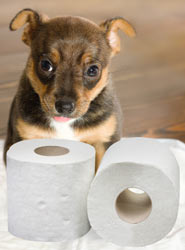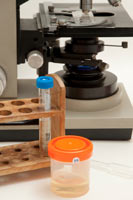Urinary Tract Infection: UTI in Dogs

Urinary tract infections (commonly referred to as UTIs) in dogs are a big cause of frequent urination and urinary accidents in the house. It is important to know about the signs, causes, diagnosis, and treatment of UTI in dogs so that you can take your dog to the veterinarian immediately if you suspect that she might have one. Any person who has suffered from a UTI knows that it is painful and miserable, so knowing when to take your dog in for diagnosis and treatment is essential to her well-being.

The urinary tract consists of the urethra, the bladder, the ureters, and the kidneys. These are all involved in urine production and the exit of urine from the body. An infection can occur in any area of the urinary tract, but the term UTI is commonly used to refer to a bladder infection.
Breeds, Gender, and Age Most Commonly Affected by UTI in Dogs
- There are no dog breeds that are more prone to UTI than others.
- UTI is more common in female dogs than in males.
- UTI can occur at any age but it is more common in dogs that are middle-aged and older.
Presentation and Signs of UTI in Dogs
Dogs with UTIs show the following signs, many of which are similar to the symptoms that a human with the same condition would report:
- Straining to urinate
- Urinating small amounts
- Dribbling urine
- Bloody or cloudy urine
- Increased odor to the urine
- Increased water consumption
- Urinary accidents in the house
- Increased licking at the vulva
Causes of UTI in Dogs
- A bacterial skin infection around the vulva that has ascended up the ureter into the bladder is a common cause of UTI.
- A vulva (the external, visible female genitalia) with extra skin folds around it allows urine to pool and develop bacteria (may also be called a recessed vulva). This is common in overweight dogs or female dogs that were spayed at a very young age.
- Excessive licking at the vulva for any reason (bacteria from the dog's mouth ascend into the bladder) may cause a UTI.
- Incontinence (unconscious leaking of urine) can lead to UTI because urine is constantly on the skin around the vulva, growing bacteria that may ascend into the bladder.
- Older, arthritic dogs may not fully empty their bladders due to joint pain because it is difficult for them to assume and hold the necessary urination position. This can lead to UTI.
- An improper pH in the urine (this can occur because of improper diet or concurrent illness) may predispose a dog to UTI.
- A weakened immune system from some other illness may allow UTI to develop more easily.
- Dogs with diabetes mellitus are more prone to UTI than other dogs because the extra sugar present in these dogs' urine encourages bacterial growth.
- Dogs with bladder stones or crystals are more likely to develop concurrent UTI.
Diagnosis of UTI in Dogs
Diagnosis of UTI in dogs is done through a veterinarian's examination and one or both of the following tests performed on a urine sample:

- Urinalysis: a multi-faceted test of your dog's urine that will reveal signs of infection such as the presence of white blood cells, red blood cells, and bacteria.
- Urine Culture: a test where any bacteria present in the urine are encouraged to multiply in a laboratory so they can be identified. Once they are classified, the laboratory often tests various antibiotics on the bacteria strain to determine which one will work well. In the case where a dog has never had a UTI before, a culture may not be done.

One big question that many dog owners have is "How do I collect urine from my dog"? Most of the time, you won't have to: your veterinarian can get the sample. There are four ways that urine may be collected to run the tests required to diagnose a UTI.
- Surface Sample: urine from the floor, the exam table, or another surface that the dog has urinated on. This is the least desirable collection method for urine because the sample may contain bacterial contamination from the surface that isn't actually present in the dog's body.
- Free Catch Sample: urine collected in a cup from the stream of urine coming from the dog's body when she urinates. This type of sample is less likely to be contaminated than one taken from a surface but it still may contain bacteria from the skin of the dog's external genitalia.
- Catheter Sample: urine extracted directly from the dog's bladder via a thin tube placed through the urethra into the bladder. This usually produces an uncontaminated sample but can be a bit uncomfortable for the patient. It is possible to introduce bacteria from the outside into the dog's bladder with this method (though this is quite uncommon).
- Cystocentesis Sample (Cysto): urine extracted directly from the dog's bladder via a needle placed into it through the dog's body wall. While many owners are shocked and concerned about this method, it is usually very comfortable for the patient and provides an uncontaminated sample for urinalysis and culture.
Treatment of UTI in Dogs
Treatment of urinary tract infection in dogs involves a course of antibiotics. Your veterinarian may do a urine culture on your dog's urine to determine the best antibiotic, but medications are often begun before the results are back from the laboratory since UTI is a painful condition. Sometimes anti-inflammatory or pain medications are also prescribed to get your dog comfortable more quickly.
Home Care for UTI in Dogs
During treatment for UTI, make sure that your dog has access to lots of fresh water and encourage her to drink as much of it as you can. Give the prescribed medication exactly as directed by your veterinarian and finish all of it.
- A dog's UTI signs will often disappear after 2 to 3 days on antibiotics, but the course of medication is sometimes up to 14 days. It is critical that you finish the entire course of antibiotics. If you don't, it's very likely that the UTI will return and it may then be resistant to that antibiotic in the future.
Your veterinarian will probably want to recheck a urinalysis after the antibiotics are finished to ensure that the infection is completely resolved.
Prevention of UTI in Dogs
Following are some things you can do to help prevent your dog from developing a UTI:
- Always provide lots of clean, fresh water and encourage your dog to drink it often.
- Have your dog examined once or twice a year as she gets older so that illnesses that affect her immune system may be caught early.
- Ask your veterinarian how you can help your arthritic dog stay comfortable so she can urinate properly.
- Make sure that you take your dog out often to urinate so her bladder stays empty.
- Watch for any evidence of redness or wetness around the vulva; it may be necessary for you to help your dog keep that area clean and dry, especially if she is overweight or very young.
- Dogs with recessed vulvas (vulvas that sit deeply inside folds of skin) are very likely to have recurrent UTI unless surgery is done to remove the extra skin.
Prognosis for UTI in Dogs
The prognosis for an individual UTI is excellent with the proper use of antibiotics. Dogs that have recurrent UTI need to have the cause properly diagnosed and treated in order to avoid a lifetime of painful episodes.
Alternative Therapies and Natural Supplements for UTI in Dogs
- Cranberry extract is sometimes used in dogs with UTI. However, if you suspect a UTI in your dog, she needs to be seen by a veterinarian. A UTI that is left untreated can spread upward into the kidneys and become very serious. Your veterinarian can help you determine whether cranberry extract would be beneficial for your dog.
-
Glucosamine supplements may help support a healthy bladder lining and decrease the incidence of recurrent UTI in dogs. They are also helpful for joint health.
- Glucosamine supplements should be in the form of glucosamine hydrochloride (HCl), not glucosamine sulfate because glucosamine HCl has better bioavailability in dogs.
You May Also Like These Articles:
How to Be Prepared for Your Dog's Veterinary Bills
Urinary Incontinence: Causes of Urine Leaking in Dogs
How to Prevent Lawn Burn from Dog Urine
Causes of Frequent Urination and Urinary Accidents in Dogs
Giving Your Dog Clean and Fresh Water
Why Does My Dog Drink from the Toilet?
Lick Granuloma: Causes, Treatments, and Prevention of Acral Lick Granuloma in Dogs
Disclaimer: This website is not intended to replace professional consultation, diagnosis, or treatment by a licensed veterinarian. If you require any veterinary related advice, contact your veterinarian promptly. Information at DogHealth.com is exclusively of a general reference nature. Do not disregard veterinary advice or delay treatment as a result of accessing information at this site. Just Answer is an external service not affiliated with DogHealth.com.


